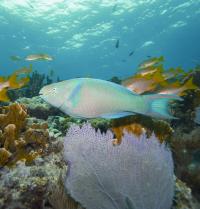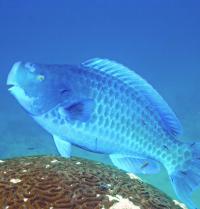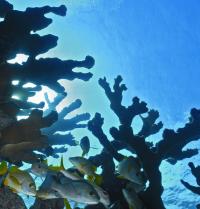
Adult male of the queen parrotfish, Scarus vetula, one of the most important grazers on Caribbean coral reefs. Threatened coral reefs could be given a helping hand by establishing marine reserves, according to a research team led by the University of Exeter. Marine reserves have already proved to be a successful way of protecting marine life against commercial fishing. Now, research published today (15 May 2007) in Proceedings of the National Academy of Sciences, shows for the first time how marine reserves could also help in the recovery of corals, which are already suffering the effects of climate change and over-fishing.
Funded by the Natural Environment Research Council (NERC) and the US National Oceanic & Atmospheric Administration (NOAA), the research was carried out on The Bahamas' Exuma Cays Land and Sea Park. At 442 square km, this is one of the largest and most successful marine reserves in the Caribbean. The team found that the number of young corals doubled in areas in which native fish, such as parrotfish, were protected from being caught. Young corals are needed to replace older corals that have been killed by storms, disease or other problems. The reserve enabled young corals to survive exceptionally well because marauding seaweeds were controlled by grazing from plentiful numbers of parrotfishes living in the reserve. 
Blue parrotfish (Scarus coeruleus), one of the largest herbivorous fishes on Caribbean coral reefs.
Lead researcher Professor Peter Mumby of the University of Exeter said: 'This is the first evidence we have that marine reserves benefit coral. Coral reefs are unique ecosystems that have supported thousands of fish and other marine species for millions of years. We estimate that humans have already destroyed around 30% of the world's coral reefs and climate change is now causing further damage to coral. These findings illustrate the need to maintain high levels of parrotfishes on reefs in order to give corals a fighting chance of recovering. This can either be done using marine reserves or national fisheries legislation that protects parrotfish.'
Marine reserves are areas of the sea that are protected against potentially-damaging human activity, like mining and fishing. Approximately 19% of the world's coral reefs are located within marine reserves. 
School of snappers (Lutjanidae) taking refuge under a canopy of the coral Acropora palmata.
Reef facts
- A coral reef is made up of thin layers of calcium carbonate (limestone) secreted over thousands of years by billions of tiny soft bodied animals called coral polyps.
- Coral reefs are the world's most diverse marine ecosystems and are home to twenty-five percent of known marine species, including 4,000 species of fish, 700 species of coral and thousands of other plants and animals.
- Coral reefs have been on the planet for over 400 million years.
- The largest coral reef is the Great Barrier Reef, which stretches along the northeast coast of Australia, from the northern tip of Queensland, to just north of Bundaberg. At 2,300km long, it is the largest natural feature on Earth.
- Coral reefs occupy less than one quarter of one percent of the Earth's marine environment, yet they are home to more than a quarter of all known fish species.
- As well as supporting huge tourist industries, coral reefs protect shorelines from erosion and storm damage.
 Print Article
Print Article Mail to a Friend
Mail to a Friend
